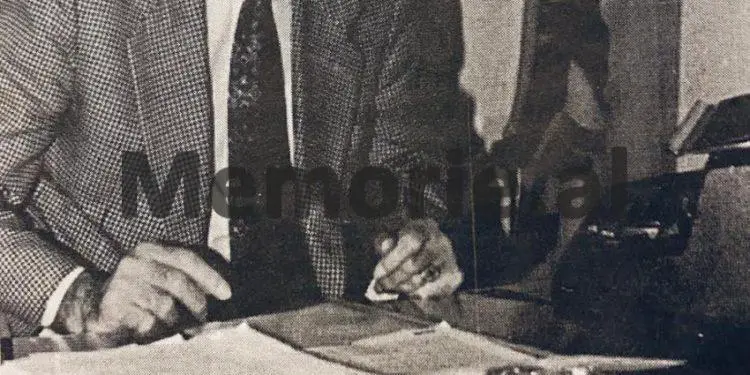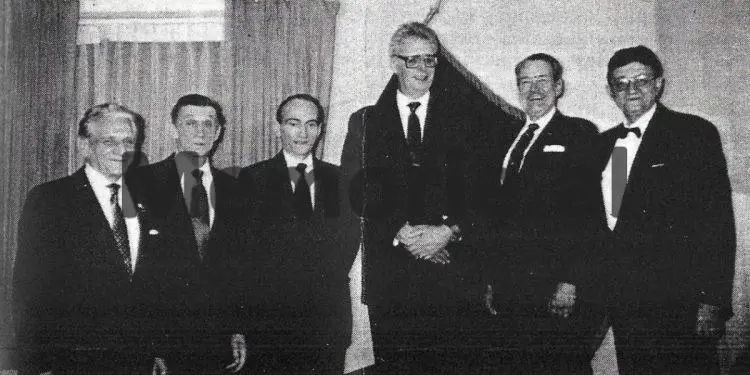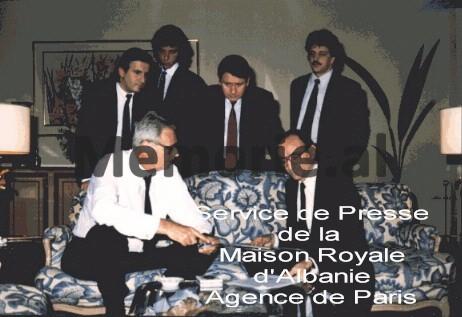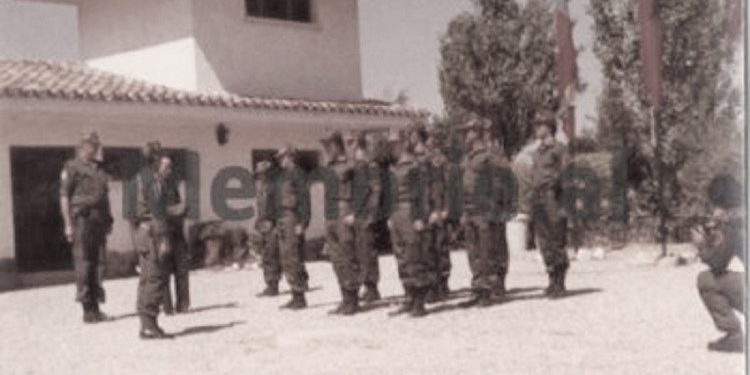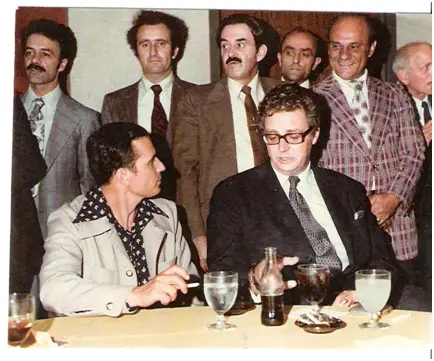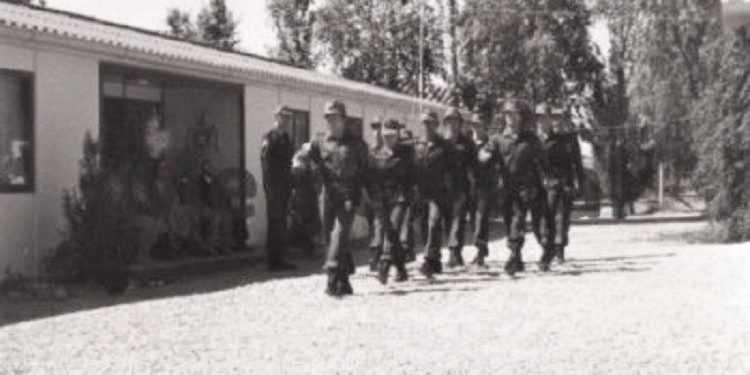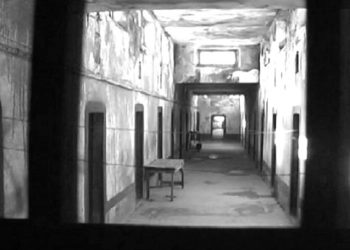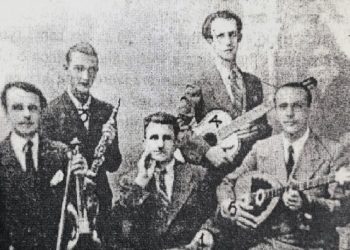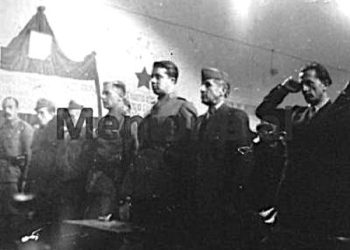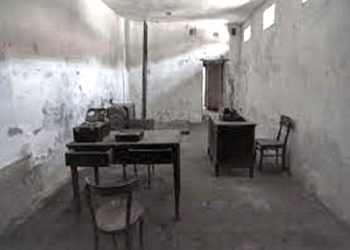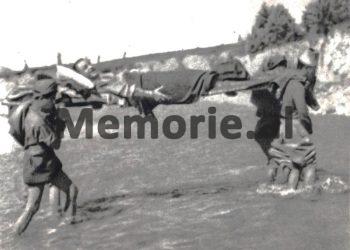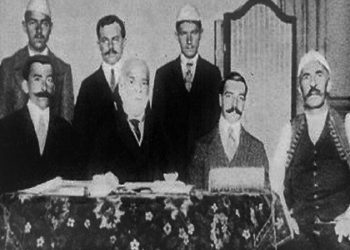Memorie.al / Over the high mountains of the Dardania region, the centuries that passed poured down unceasing storms of torrents. Upon the shoulders of the peaks, numerous giant lightning flashes illuminated the sky, seeking to conquer the resistance of the Dardanian nobles. But neither the storms nor the lightning could bow the head of the mountain, which drew pride from the valor and bravery of its sons. In this mountain range of resistance, Abedin Mulosmani was born and raised on May 5, 1938, in Fang of Bujani, in Krasniqe. He would be just 3 years old when his grandfather’s famous towers were struck by Italian artillery, solely because the Mulosmanaj family had taken an active part in the resistance of April 7, 1939, opposing the Italian invader with arms in hand.
The shelling and aerial attack on Binak Alia’s towers signaled the start of open war between a handful of heroic men and thousands of Italian soldiers. An order from the high Italian occupation command (issued in July 1941) informed that: “the rebels, Male Shaban Mulosmanaj and Zenun Ali Mulosmanaj, as organizers of the bloodshed on April 7, 1939, must be immediately arrested and, in case of non-surrender, executed.”
Male Shaban Mulosmanaj, Abedin’s father, carried on his shoulders an entire history of wars and endeavors for the independence of the Albanian ethnic lands. When he was still young and had just started to shoot a rifle, his own father, Shaban, was surrounded by the Turkish army, and fighting 20-25 soldiers, they managed to capture the single brave man alive. Known for his bravery, both against the Serbs and the Turks, two days after he was imprisoned, the firman (imperial decree) ordering Shaban’s hanging arrived in Gjakova from the Sublime Porte. Thus, in October 1910, Shaban Mulosmani was hanged in the Gjakova bazaar, passing on his heroism and patriotic spirit to his sons.
Mal Shabani actively participated in the military actions of the declaration of Albanian independence and, later, led the çeta (armed band) of Fang to protect Krasniqe from the annexationist actions of Serbia. For his distinguished merits in the Albanian national movement, in 1924, on the initiative of the Albanian Minister of War, Mal Shabani took the duty of an officer with the rank of lieutenant in our national army. In this duty, at all times, both his devotion to the homeland and the unwavering loyalty of the son of Krasniqe to King Zog would stand out.
The bravery of Male Shaban Mulosmani is well known, especially in protecting the northeastern borders of Albania, within the framework of the Albanian Border Guard. Equipped with high combat qualities, Abedin’s father, with a handful of men from Gjakova, became the terror of Serbian and Bulgarian combat formations. This is the reason why, on November 28, 1937, Male Shabani was decorated by the Commander-in-Chief of the National Army, King Zog the First.
As mentioned earlier, the Mulosmanaj towers, during the years 1924-1939, turned into generous hearths, not only for Ahmet Zogu but for all supporters of the Albanian Monarchy. Seeing in this Monarchy the great shift of Albania towards the motherland, the Mulosmanaj transformed into brave outposts of the Albanian Kingdom. “When Fascist Italy treacherously occupied our country on April 7, 1939, the Mulosmanaj remained loyal to the homeland, the nation, and the King, and in order not to submit to the Blackshirts of Rome, Major Zenun Ali Mulosmanaj and Lieutenant Male Shaban Mulosmanaj, along with their families, immigrated to Sarajevo.” (Atdheu Newspaper, Sunday, September 23, 2001).
In January 1944, Male Mulosmani’s family returned to their birthplace, Fang of Krasniqe, with great hope of living forever in the homeland. But even there they found no peace, because the fratricidal war had begun to play the great tragedy of the Albanians. Male Mulosmanaj lined up with the nationalist forces of Krasniqe from the first days of January, based on the strong idea that the “alliance” between the communists of Tirana and those of Belgrade was nothing but a bad omen for Ethnic Albania.
During 1944, Male Mulosmani, leading 20-30 men from Krasniqe, did everything possible to gain the Albanian ethnic borders, according to the ideas of the Second League of Prizren. And indeed, the alliance between Belgrade and Tirana would not last long. The thousands of young men from Kosovo and Albanian Macedonia, killed by treacherous Serbo-Slavic and Albanian communist rifles, prove this. Meanwhile, for the Mulosmanaj towers, with the “great” victory of the national-liberators, there would be no peace.
The Bolsheviks of Tirana had denied the emblematic gathering of the Second League of Prizren and rushed like beasts against the torchbearers of these ideas. In March 1945, Male Mulosmani’s tower was entirely burned by the forces of the People’s Defense Division, which, in fact, became a terror for the nationalist population of the northern Albanian regions. It is by no means a coincidence that the bloodthirsty Shefqet Peçi and Hysni Kapo commanded these Bolshevik forces.
Since Male Mulosmani had lined up with the Albanian anti-communist resistance forces, after burning his tower, the communists interned his family in a distant village in Berat. Here, 7-year-old Abedin, although in extremely difficult conditions, following his mother’s advice, sat at school desks. The Bolsheviks of education, even at school, created an almost unbearable situation for the “enemy of the people.” But the seven-year-old boy, accustomed to emigrating since he was 3 years old, would always remain silent; he would learn the beloved alphabet through the fierce glances of his peers, indoctrinated by the cancerous disease of communism.
In the autumn of 1946, the former Major of the Zog Monarchy, Zenun Ali Mulosmani, was killed in a clash with communist forces, while Male Shabani was arrested through betrayal. The infamous Albanian Sigurimi (Secret Police) made every effort to bring Male to their side, but the latter maintained a firm and manly stance until the last moment. When they saw that their game was failing, high-ranking officers of the Albanian Sigurimi, in cooperation with the Russian ones, prepared the macabre death of the man of Krasniqe in the cells of Shkodra prison, fearing his trial and imprisonment, because he might speak about the communist villainies regarding his “rehabilitation.”
In this way, in December 1948, Male Shabani’s lifeless body was found one morning, which was dumped somewhere, as the body could not be handed over to the family. Without notifying them at all of this disaster, the communists of Tirana, under the pretext that the Mulosmanaj might be dangerous in Berat, sent them as a family to the fortress of Tepelenë, a real hell built according to models invented by Stalin. Here, Abedin, now 10-11 years old, would be subjected to another severe ordeal, where besides reading school books, he would have to work several hours a day to earn a living, so as not to be a burden on the family.
In the summer of 1951, taking advantage of a multi-day leave to visit some relatives in Berat, the families of Male Shaban Mulosmani and Çele Shaban Mulosmani, also considering their endangered lives, headed towards the border with Yugoslavia. After two or three days of suffering and great sacrifices, they managed to leave behind the Albanian communist hell.
Today, in the archive of the Ministry of Internal Affairs in Tirana, there are still a number of documents from the communist regime officials of that time, sent to the Yugoslav UDB, for the extradition of the Mulosmanaj. But fate saved the men and boys of Krasniqe this time. The Yugoslav side, for their exchange, had requested some of its collaborators who had been killed in the cells of the Albanian investigation, and here the misery of the Mulosmanaj ended.
After several months of supplementary lessons, Abedin Mulosmani, in 1952, enrolled in the high school of Gjakova. His surname in Gjakova and its surroundings was now called with great respect by teachers and students. This fact obliged Abedin to study incessantly and with extraordinary willpower. In the summer of 1958, Abedin Mulosmani’s report card stood out among all the high school students of Gjakova, both for high grades and for exemplary behavior in and out of school.
In the years 1960-1963, Abedin worked as a teacher in Istog of Peja. In these three years, he would connect with his students, even before the paths of knowledge, through the wonderful expressions of his Albanian identity. Once, when he was called by the Serbian authorities and cautioned for mentioning the histories of the Albanians too often, he replied that it was their history and no one had the right to deny it to them.
Because he maintained such a stance, for four years in a row, the educational institutions of Belgrade denied the son of Krasniqe the continuation of faculty. Only in 1965, with the intervention of some Albanian personalities of education in Prishtina, Abedin Mulosmani was allowed to continue University studies, in the Faculty of Economics. Even here, in the first two years, Abedin would achieve extremely high results, making his personality embody both the will for knowledge and the immense desire to enrich the lands of heroic Kosovo as much as possible.
However, Albanians who came from the mother state for political reasons were always at risk from Serbo-Slavic-Macedonian psychological and physical violence. This is the reason why, in 1967, the United Nations took the initiative to remove many political asylum seekers from communist states, especially those coming from the mother state, to Western countries. Thus, also considering their wishes, the American state opened its doors, both for many Albanians and for the Mulosmanaj. In November 1967, Abedin, now 29 years old, with a complete intellectual formation, faced the Western metropolis without batting an eyelid.
Initially, he took on various jobs to have the opportunity later to follow the great path of Albanian nationalism. Thus, in the early 1970s, together with dozens of his compatriots, nationalists and monarchists, he organized a series of rallies in America, in defense of the rights of Albanians living under the clutches of Bolshevism in Albania, as well as under Serbo-Slavic-Macedonian violence in Kosovo and Albanian Macedonia. For two years in a row, 1975-1977, Abedin Mulosmani was the editor of the newspaper “Atdheu” (Homeland), published in the United States of America.
With his fighting spirit, his realism in describing the times, and his courage in exposing the Bolshevik ideology, Abedin Mulosmani became a symbol of Albanian resistance for freedom and democracy in all Albanian ethnic territories. The clarity of his thought and the open call to unite in the front against communism, to unchain his compatriots, greatly increased the authority and respect for the son of Krasniqe, the grandson of the legend, Binak Alia.
Precisely in the summer of 1977, following some of his published ideas regarding the enlightened period of the Albanian Kingdom, Abedin Mulosmani was summoned to Spain by His Majesty, King Leka I. Two years of work and great anti-communist and patriotic activity there would be enough for the son of Krasniqe to ascend (August 1979) to the function of Minister of the Court, where Abedin Mulosmani would not confine himself to working in comfortable offices.
Rich in great courage and energy, in the spring of 1978, for 4 months in a row, Abedin stayed on a small military vessel, very close to the Albanian coast, sending thousands and thousands of leaflets in plastic bags, through which Albanians were informed that the Military Council for the liberation of Ethnic Albania had been formed, led by H.M. Leka I, and which, among other things, appealed against Enverist communism.
The truth is that the Albanian state of that time mobilized large coastal guard forces to track down this vessel, but no trap could catch Abedin Mulosmani! Meanwhile, entire battalions of soldiers along the Sarandë-Borsh coastline waited every morning, as if in war, for the leaflets, collected them, and burned them in secrecy, fearing they might fall into the hands of the simple people, chained in spirit by communist dogmas.
After this act, Abedin Mulosmani went to Spain and prepared other propaganda materials. He gave dozens of interviews on European radio, television, and newspapers, calling on civilized nations to intervene energetically and not to stand idly by regarding the violation of the elementary rights of his compatriots in Kosovo, Albania, and Albanian Macedonia.
And again in the following years, he appeared on the shores of the Adriatic, throwing leaflets in pure Albanian, openly calling on his compatriots to rise up with arms against the communist clique led by Enver Hoxha. Although the Cold War between East and West had its iron laws, Abedin Mulosmani, through these leaflets (where his life was often at risk), wanted to convey across Europe the great message that communism had turned from a hope into a terrible reality for its own people.
Frightened by the resurrection of the royal images, the communist clique of Tirana undertook a series of diplomatic actions against the existence of the Albanian Royal Court. It was precisely these diplomatic moves by Tirana and Belgrade that led, in 1979, to the refusal of the Spanish government for the residence of H.M. Leka I in Madrid. Even in these moments of great tension, Abedin Mulosmani did not bend.
He faithfully faced the diplomatic and physical displacement of the Royal Court, convinced that this was another trap set by the Eastern intelligence services to hold H.M. Leka I hostage, as well as all Albanian Royal glory. He was completely convinced that the removal of our Royal Court from Spain was intended to strike a severe blow to Albanian nationalist activity, but the time that followed proved the opposite.
Upon settling in South Africa, the Minister of the Royal Court, Abedin Mulosmani, quickly exchanged information, ideas, and protests with other royal families, seeking their help regarding diplomatic and propaganda efforts against the Spanish government. It must be said that that extreme measure taken by Madrid at the time remains a black stain on the Spanish Monarchy itself. The 1980s remain intensive years for Abedin Mulosmani, both in terms of propaganda actions against communism in Albania and diplomatic efforts to expose the fierce physical violence against Kosovo and Albanian Macedonia.
Naturally, the overthrow of the totalitarian regime in the mother state in March 1992 was followed by great emotions at the Royal Court in South Africa. Hundreds of congratulatory telegrams arrived those days from loyalists of the Monarchy from Albania, Kosovo, Albanian Macedonia, France, Belgium, and America, reminding H.M. Leka I that the paths to his beloved homeland were open forever. During the years 1992-1993, Abedin Mulosmani faced great problems in bringing the new King to Albania, wisely and maturely circumventing a series of Albanian mentalities indoctrinated by five decades of dictatorship.
I would like to include here one of his statements, in April 1997, in Tirana, when the Albanian Telegraphic Agency addressed the Minister of the Royal Court, Abedin Mulosmani, to say something about April 7, 1939. Among other things, in this speech, he announced: “On April 6, 1939, Fascist Italy presented ultimate demands for the submission of Albania without a fight.
Zog I and the Albanian government, faced with this ugly ultimatum from an allied state, had two paths: accepting the ultimatum or declaring war against the invader. He summoned the Parliament, presented his stance against this ultimatum, which the Parliament unanimously approved, and thus chose the path of honor, which could not avert defeat, but saved national honor and pride.” (From the speech of Mr. Abedin Mulosmani, given to ATSH, dated April 6, 1997).
In the great north-south tour organized by H.M. Leka I in the spring of 1997, the speech and mature thought of the Minister of the Royal Court, Abedin Mulosmani, shone brightly among other things. The main theme of his speeches, from Delvinë to Koplik, from Zerqan to Himarë, was the words peace, unity, brotherhood. The storms of applause certainly would not cease when, at the end of every speech, he would mention with veneration the freedom of all Albanian ethnic territories.
His thought about Ethnic Albania not only did not fade but shone ever brighter in every situation. At every moment, when evoking the past of the Royal Family, Abedin Mulosmani clearly reminded his interlocutors that the linear movement of time not only did not diminish the splendor of the Albanian Monarchy but, on the contrary, invited the rebirth of that great era in our history. I find it necessary to underline in this writing two or three passages from the speech of the Minister of the Royal Court in Tirana, on the occasion of the 100th anniversary of the birth of King Zog I.
“On April 9, 1961, Zog I passed away in Paris, France, and he left as heir to the Zogist Dynasty, his son, H.M. Leka I, King of the Albanians, who took the oath that same day and took upon his shoulders the heavy burden of the legitimacy of the Albanian Monarchy, according to the Constitution of 1928, which undeniably expresses and preserves the Legitimacy and will of the Nation, inside and outside the borders of political Albania, dedicating his life to Ethnic Albania, the welfare and future, as well as the happiness of the Albanian people, to be Masters and proud in their Illyrian-Dardanian lands.
Our August Sovereign, King Leka I, closely following the national and international situation, and seeing the dangers threatening our ethnic lands, appeals for vigilance and caution, to guard against the risk of the Government being taken by the old communist forces, calling on all compatriots to support the Albanian Right League, as well as all democratic right-wing forces, for national understanding among them.
The deplorable situation of our sisters and brothers in Kosovo, Montenegro, and Macedonia, as well as in martyr Chamëria, must be our main preoccupation. This was the stance of King Zog I during the Zogist era in the Homeland, and during the years of exile, and this has been and is currently the ideal and dedication of H.M. King Leka I, King of the Albanians.
In conclusion, I express my sincere pleasure and congratulations for this 100th-anniversary jubilee of King Zog I, and I once again bring you the most fraternal congratulations and greetings of H.M. Leka I, King of the Albanians.”
Long live Ethnic Albania and long live the Albanian people!
(Atdheu Newspaper, Tirana, October 14, 1998).
The troubles, the difficulties of life, and the intense daily activity would weary Abedin Mulosmani’s generous heart. But to the shame of history, he would also be excessively weary of a decision by the Albanian judicial bodies (in the hands of the new Albanian Bolsheviks), who, following in the footsteps of their fathers, through a sham trial, convicted the Minister of the Albanian Royal Court in absentia for alleged participation in an armed uprising.
The son of the famous tower of Binak Alia – that tower which cracked the caps of the Serbs, which the Turks surrounded and burned, which the Italians bombed, which the communists of Tirana dynamited – is now sought to be shackled by his own compatriots, the Euro-Socialists.
But the man of Krasniqe was not afraid at all. He got ready for the march again, as a good soldier of Ethnic Albania, he set off, but death did not let him. It took into its black embrace the indomitable personality of the Royalist and Legalist Movement in Albania and the diaspora, leaving in sorrow the long ranks of monarchists, ready to sacrifice themselves for the freedom of their ethnic territories. Memorie.al




